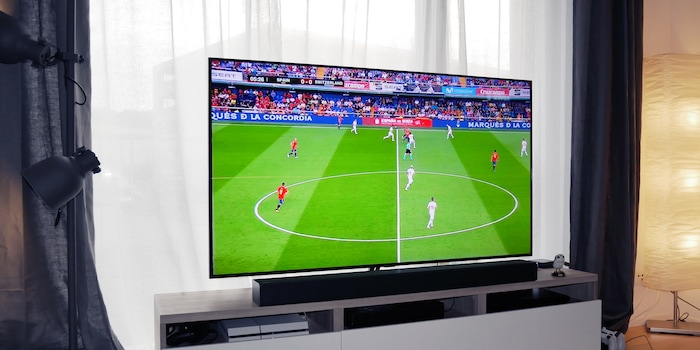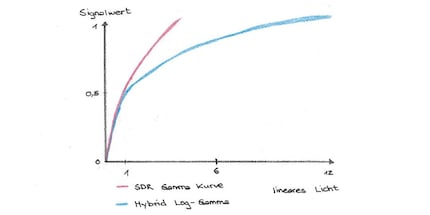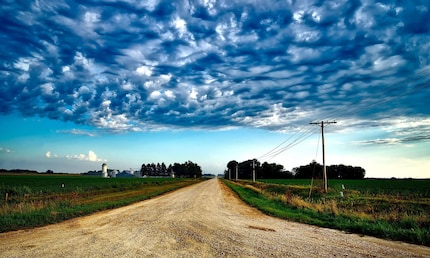
The future of live TV: how HLG works
HDR promises you the richest and most natural colours you have ever seen. The upcoming World Cup is set to make the technology acceptable for live TV - thanks to Hybrid Log Gamma. But how does it actually work?
HDR, or High Dynamic Range, is currently the most exciting technology on the television market. No UHD television can do without its support these days. I would even argue that HDR has a greater impact on the picture than UHD resolution.
Hybrid Log Gamma, or HLG, is a relatively unknown type of High Dynamic Range - similar to HDR10 or Dolby Vision. All three formats promise you a picture with the richest and most natural colours you've ever seen. So what's the difference?
While streaming platforms such as Netflix and film studios have leased the HDR10 and Dolby Vision formats for themselves with their 4K Blu-rays, HLG is considered the HDR format for live TV. Although there is hardly any HDR content to be seen there, the upcoming football World Cup should change that. Then HLG will be much more relevant for you than you think.
Get curious?
This is Hybrid Log Gamma
Short repetition: High Dynamic Range means that the contrast range, i.e. the difference between the darkest and lightest areas in the image, is much higher than usual. This allows even more, richer and more natural colours to be displayed. The HDR signal can be encoded in different ways - i.e. formats - into the signal that your TV receives from the broadcaster and then processes.
By the way, I have already written extensively on the topic of HDR, in particular on the two formats HDR10 and Dolby Vision. If you feel like it, you can read it here:
So now comes Hybrid Log Gamma. HLG is a fairly unknown form of HDR and has two major advantages over the existing formats:
- It is much more suitable for live TV than the common HDR10 or Dolby Vision formats
- Unlike other HDR formats, HLG is backwards compatible with TVs that do not support HDR images
Backwards compatibility in particular is a huge argument for live TV.
An example:
If SRF only broadcast the latest edition of "Kassensturz" with an HDR10 signal, everyone who doesn't yet have a new TV would see nothing. This is because the old TVs cannot handle the HDR signal, which is certainly not in the interests of the broadcasters. They are dependent on being seen by as many people as possible in order to survive. Viewing figures send their regards.
So if the broadcaster does not send a separate signal without HDR, then it looks like it's going to be a complete mess. In most cases, the bandwidth required to run several signals in parallel on one channel is lacking. Incidentally, this was also the reason why SRG needed a separate channel for its HD signal at the time.
Nobody wants a multi-channel mess like that today. So another solution is needed. And this is where HLG comes into play.
What HLG does differently
In order for your TV to know what the high-contrast images should look like, it needs metadata. This can be found in the television signal. The metadata itself contains information on image brightness, contrast and colour saturation, among other things. In other words: "This is what HDR looks like, now you can do it". At least with HDR10 and Dolby Vision.
For live TV, however, the metadata is a problem.
The risk of even a small part of the metadata being lost during television transmission is high enough to make heads spin. It can also happen that the metadata does not arrive on your TV in synchronisation with the picture. If a dark scene follows a bright scene and the bright scene is already fed with the meta information of the dark scene, you get an insanely overexposed picture.
HLG solves the problem by simply leaving out the metadata. Instead, it uses the standard dynamic range signal - or SDR signal for short - as the starting point for the subsequent image. After all, every television knows what to do with the SDR signal. Information about HDR is "superimposed" on the signal, as you can see in the graphic below. Normal televisions ignore this information, whereas HLG-enabled TVs show a beautiful HDR picture.
Somewhat more technically speaking: Hybrid Log Gamma uses a typical gamma curve of the current Rec. 709 colour space in the lower half of the transfer function. Rec. 709 contains about 35 per cent of all the colours that the human eye perceives and that a normal television can display without HDR.
HLG "sticks" a log function in the upper half of the transfer function. "Log" and "Gamma" - that is the reason why it is called "Hybrid Log Gamma".
This looks something like this:

Source: Gezeichnet von Luca
The vertical axis shows the signal value of the broadcaster. "0" here means black, while "1" is the brightest white. The horizontal axis shows the brightness - i.e. the physical, linear light - as it comes out of your television.
You can see from the graph that there are far fewer differences in brightness between the average (0.5) and highest (1) signal values with SDR quality than with HLG. Or metaphorically speaking: An ordinary cloudy sky looks consistently white on an SDR TV because everything is more or less the same brightness. On an HDR television, on the other hand, you can recognise much more detail and structures in the cloud cover because there are many more brightness levels. Not all white is the same.
And that's basically what HDR is all about.

Source: Pinterest
To summarise all the technical gobbledygook from up there: Using Hybrid Log Gamma, even those TV sets without HDR support can receive and process HDR quality. This is the big advantage of HLG over HDR10 or Dolby Vision.
But there are also disadvantages
Well, thanks to Hybrid Log Gamma, broadcasters don't need a separate signal to bring HDR images to your TV. Everything seems to be easier with HLG anyway. Why doesn't everyone, including streaming suppliers and film distributors with their 4K Blu-rays, switch to HLG right away?
Firstly, it's a question of picture quality. HLG is good, but not as great as HDR10 or Dolby Vision. Take another look at the graphic above. There you can see that HLG only displays more brightness levels in the upper brightness spectrum than the SDR signal. In contrast, HDR10 and Dolby Vision increase the entire spectrum - even in dark areas. In the graphic above, this would be the range between 0 and 0.5.
On the other hand, there are certain problems with compatibility. This is the case when an HLG signal reaches an HDR-capable TV that supports the HDR10 and Dolby Vision standards, but not HLG. HLG is therefore backwards compatible with SDR televisions, but not with HDR televisions that do not support the HLG format.
Someone should understand why.
But before you think that you would prefer the other two formats in this case: What's the point of better technology if it doesn't work for live TV anyway?
What does that mean for you?
When it comes to HLG compatibility, the major TV manufacturers such as LG, Samsung and Sony have all been on board since the 2017 models at the latest. 2016 models often did not offer HLG support ex works, but most TVs have been retrofitted with a firmware update. Nevertheless, if you want to know for sure, it's best to ask the manufacturer.
HLG sources are not yet available in today's live TV. In any case, I don't know which free TV channel broadcasts a hybrid log-gamma signal. If you know of one, please feel free to add it in the comments field.
In the future, things will look different, as many broadcasters have expressed great interest in the format. In fact, the upcoming World Cup could bring a turning point. FIFA is producing it in ultra HD resolution and HDR quality. If this goes down well with people, it could be the kick up the backside that many broadcasters need to switch to HDR for live TV as well.
About the World Cup...
This will make the ball even rounder and the grass even greener
SRG will compile the FIFA programme signal in Zurich. For a fee, broadcasters could decide in favour of or against the UHD HDR signal. Only Swisscom made the decision. So if you want to watch the World Cup in HDR quality, you need Swisscom TV.
In detail:
- In Switzerland, only Swisscom is broadcasting the World Cup in UHD HDR picture quality
- You will need Swisscom TV and a UHD-compatible Swisscom TV box
- Your TV must be UHD-capable and support at least one of the two HDR standards HDR10 or HLG
- You need an internet connection with a bandwidth of at least 33 Mbit/s
I write about technology as if it were cinema, and about films as if they were real life. Between bits and blockbusters, I’m after stories that move people, not just generate clicks. And yes – sometimes I listen to film scores louder than I probably should.
Interesting facts about products, behind-the-scenes looks at manufacturers and deep-dives on interesting people.
Show all